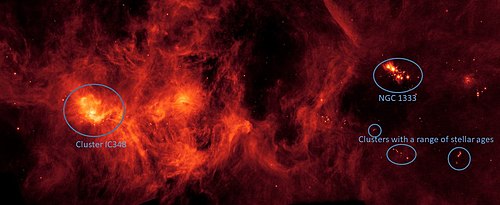The Perseus molecular cloud (Per MCld) is a nearby (~1000 ly) giant molecular cloud in the constellation of Perseus and contains over 10,000 solar masses of gas and dust covering an area of 6 by 2 degrees. Unlike the Orion molecular cloud it is almost invisible apart from two clusters, IC 348 and NGC 1333, where low-mass stars are formed. It is very bright at mid and far-infrared wavelengths and in the submillimeter originating in dust heated by the newly formed low-mass stars.
It shows a curious ring structure in maps made by the IRAS and MSX satellites and the Spitzer Space Telescope and has been detected by the COSMOSOMAS at microwave frequencies as a source of anomalous "spinning dust" emission.
References
- ^ a b c d "NAME Perseus Cloud". SIMBAD. Centre de données astronomiques de Strasbourg. Retrieved 2014-03-14.
- ^ Ortiz-León, Gisela N.; Loinard, Laurent; Dzib, Sergio A.; Galli, Phillip A. B.; Kounkel, Marina; Mioduszewski, Amy J.; Rodríguez, Luis F.; Torres, Rosa M.; Hartmann, Lee; Boden, Andrew F.; Evans, Neal J. II; Briceño, Cesar; Tobin, John J. (2018). "The Gould's Belt Distances Survey (GOBELINS). V. Distances and Kinematics of the Perseus Molecular Cloud". The Astrophysical Journal. 865 (1): 73. arXiv:1808.03499. Bibcode:2018ApJ...865...73O. doi:10.3847/1538-4357/aada49. S2CID 119422324.
- Bally, J.; Walawender, J.; Johnstone, D.; Kirk, H.; Goodman, A. (December 2008). The Perseus Cloud. Vol. 4. p. 308. Bibcode:2008hsf1.book..308B. ISBN 978-1-58381-670-7.
{{cite book}}:|journal=ignored (help) - Kirk, Helen; Johnstone, Doug; Di Francesco, James (August 2006). "The Large- and Small-Scale Structures of Dust in the Star-forming Perseus Molecular Cloud". The Astrophysical Journal. 646 (2): 1009–1023. arXiv:astro-ph/0602089. Bibcode:2006ApJ...646.1009K. doi:10.1086/503193. S2CID 1173412.
- More on THE ASTROPHYSICAL JOURNAL http://iopscience.iop.org/0004-637X/656/1/293





Recent Comments